
|


Woodstock III
"A Day in the Garden"
August 14, 1998
Times Herald Record
August 14, 1998
By Jeremiah Horrigan
Staff Writer
That was then, this is now, at Bethel.
Back then. Day One of the 1969 Woodstock
Music and Art Fair
- The hordes arrive. Route 17B becomes the world's longest two-lane
parking lot.
- We're not in Kansas, but it sure looks it.
- Richie Havens opens the show.
- Hot and sunny skies; weather looks perfect.
- First skinny-dipper sighted.
- One thousand photographers take note.
- Scalpers sell tickets to innocent high school kids.
- Kids save tickets, make collectible killing 29 years later.
- Richie Havens sings for three hours. Main stage construction
nearly done.
- Showers at midnight.
Just now. Day One of the Day In The Garden.
- Route 17B never looked so empty.
- We're still not in Kansas. Maybe Disneyland?
- Afroblue opens at 9 a.m. on tiny second stage. Plays half an hour.
- Cloudy skies look ominously familiar. First sprinkles fall on
press tent, 10 a.m.
- Skinny dipping prohibited without official skinny dipping pass.
- One thousand apply for skinny-dipping review board.
- Scalpers sell bogus parking passes to innocent 48-year-olds.
- Innocent 48-year-olds embarrass their children with their Pete
Townshend windmill-rocker moves.
- Alvin Lee of Ten Years After invites
crowd to boogie. Crowd obliges.
- Illicit bottled water confiscated.
The Times Herald-Record Print Edition
Copyright August, 1998,
Orange County Publications, a division of Ottaway Newspapers
all rights reserved.
|
|
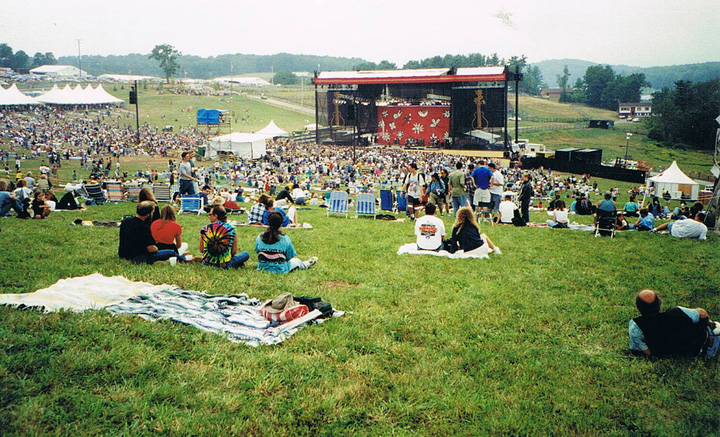
August
14,1998
Ten
Years After return to the site of the original 1969 Woodstock Festival
to perform before 14,000 people at the
“Day In The Garden” Festival. Almost thirty years after their
legendary performance on this farm-site, Ten Years After are introduced
as:
“The
Band Who Rocked The World!”
Their
set list includes the following numbers and is only available on “Bootleg”
CD. The following is from our personal bootleg collection.
- Rock
and Roll Music To The World 3:45
- Hear
Me Calling 5:45
- Love
Like A Man 5:35
- Good
Morning Little School Girl 7:15
- Hobbit
5:35
- Slow
Blues In C 8:15
- Johnny
B. Goode 1:55
- I
Can’t Keep From Crying Sometimes 14:55
- I’m
Going Home 12:15
- Choo
Choo Mama 4:25
- Rip
It Up 3:00
From
a fan:
Wow!!
I just finished watching the live internet broadcast of a Day In The
Garden festival, and the band looked fantastic playing two encores, and
a great version of I’m Going Home…Great Job!!!
|
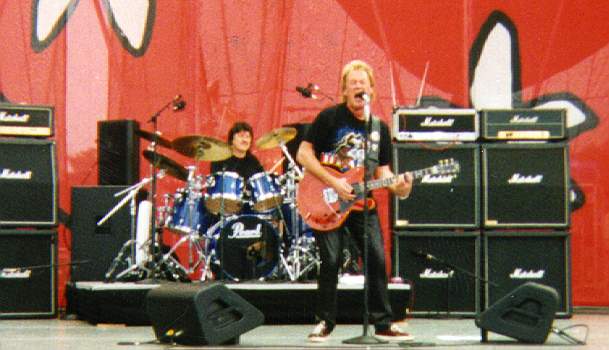
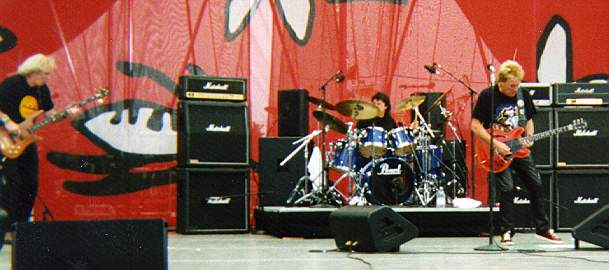

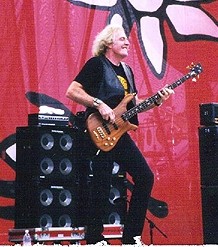
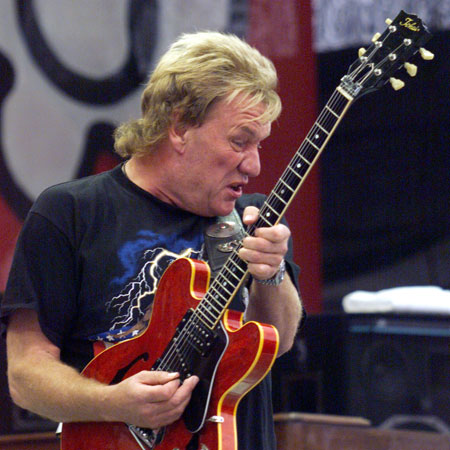
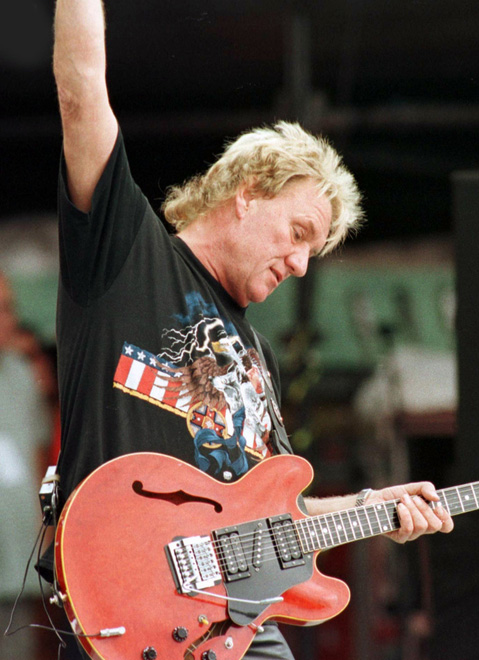

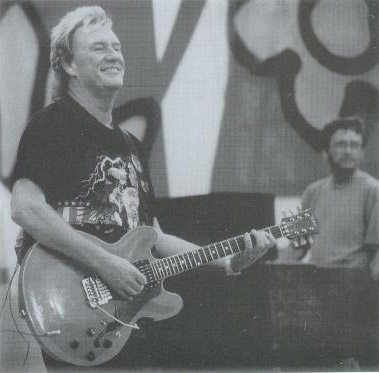
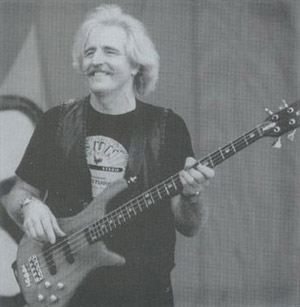
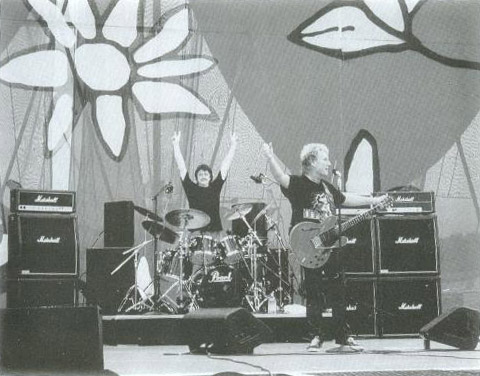
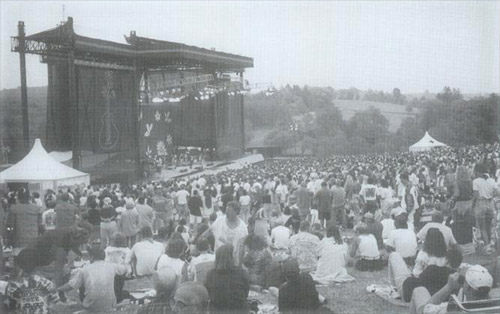

Thanks to Torsten Strube  for this great photo (taken at "Torsten's Garden")
for this great photo (taken at "Torsten's Garden")


'Garden' party isn't epic, but fun
Albany Times Union
August 14, 1998
By Greg Haymes
Staff Writer
BETHEL -- There was a peaceful, easy feeling on Friday at A Day
in the Garden, and it wasn't just because head Eagle Don Henley was
one of the performers.
The vibe was right for an anniversary show on Max Yasgur's Farm
-- the site of the original Woodstock Music and Arts Fair 29 years
ago -- and the music maintained the mellow mood.
Along with Henley, A Day in the Garden hosted headliner Stevie
Nicks, veteran blues-rockers Ten Years After, second-generation
reggae star Ziggy Marley and relatively unknown pop-rocker Francis
Dunnery.
British-born Dunnery might have seemed like an odd selection to
kick off the fest, but it was an inspired choice. The little-known
guitarist-vocalist -- who founded the progressive rock band It Bites
and played in Robert Plant's band before launching his solo career
-- played at Valentine's in Albany just a few short weeks ago, but
he seemed right at home leading his new band on the huge Garden
stage.
In true Woodstock spirit, he opened the fest with
"Revolution,'' but it wasn't a call for political overthrow.
Instead, in true '90s fashion, he sang, "I feel a revolution
inside of me.'' In defiance of the gathering clouds, Dunnery and his
tight backing trio offered the shimmering ballad, "Sunshine,''
but he hit his high-water mark with the back-to-back blast of
infectious, thinking man's pop, "My Own Reality'' and "Too
Much Saturn.''
Ziggy Marley led a sprawling 14-piece band, the Melody Makers,
and it was clear from the opening volley of "Rastaman
Vibration,'' that he wasn't going to shy away from the rich catalog
of song by his legendary father, the late reggae pioneer, Bob
Marley. In fact, it was his father's repertoire that made up the
bulk of the young Marley's 40-minute set, including notable
renditions of the rousing "Get Up, Stand Up,'' and set-closing
"Jammin' '' and a magnificent reading of "No Woman, No Cry.''
Ten Years After -- the only band on Friday's bill who performed
at the '69 Woodstock fest -- seemed to be something of a curious
museum piece. Despite that, the band featured the same lineup that
they had in '69, their brand of bruising blues 'n' boogie hasn't
progressed or evolved much over the years.
"This is a cool piece of deja vu, huh?'' guitarslinger Alvin
Lee asked the crowd, and, yes, I guess it was, but unfortunately it
wasn't much more. Tired blues classics like "Good Morning,
Little Schoolgirl'' and an ill-advised stab at Woodstock sing-along
with Chuck Berry's "Johnny B. Goode'' fell flat, but they hit
the mark with "I Can't Keep From Crying,'' an epic slab of
psychedelic blues that captured all the best of Woodstock-era jams
while quoting from Cream and Hendrix. Of course, it was all just a
warmup for a reprise of the monstrous "I'm Goin' Home'' from
'69, which Lee stretched out to a whopping 12 minutes, including
forays into the songbags of Elvis Presley and Jerry Lee Lewis.
Henley was the musical highpoint of the day, counterbalancing the
peace 'n' love nostalgia with a biting dose of California cynicism.
Backed by a six-piece band and trio of blond bodacious vocalists,
Henley opened with "The Boys of Summer,'' featuring the
anti-nostalgia lyric, "Don't look back, you can never look
back.''
"This is for Bill,'' he said, dedicating his swipe at media
muckraking, "Dirty Laundry,'' to President Clinton. He offered
scathing readings of Leonard Cohen's "Everybody Knows'' and
John Hiatt's "Shreddding the Documents,'' before really going
for the throat by dedicating "The End of the Innocence'' to the
memory of Max Yasgur. "Max, you had a beautiful farm. I
understand that it's not going to be that way for much longer, but
this is for you, Max.''
He also tossed in a weird reggae version of "Sit Down,
You're Rockin' the Boat'' from the Broadway musical "Guys and
Dolls,'' and, of course, he also ran through his hits -- most
notably the gutwrenching "The Heart of the Matter,'' the
cinematic "Sunset Grill'' and the rocking "I Will Not Go
Quietly.''
But he didn't touch his wealth of Eagles' material until his
double-barreled encore when he got behind the drums for "Hotel
California'' and the haunting "Desperado.''
Nicks seemed anticlimactic after Henley's tour de force, although
it didn't help matters any that the rains finally came down at the
start of her start and lasted for about an hour. It was the final
date on Nicks' Enchanted tour in support of her three-CD boxed set,
and she pulled out songs from throughout her career. Backed by seven
musicians and two vocalists, Nicks was at her best on "Stand
Back,'' "Gold Dust Woman'' and a set-closing medley of "Nightbird''
and "Edge of Seventeen,'' but her constant costume changes
destroyed the momentum of the performance. The rain did, however,
keep her trademark twirling to a minimum.
Was Day One of A Day in the Garden a musical milestone? Hardly.
Was it magical? Not at all. Was it fun? You bet.
As Henley sang in "Hotel California,'' "We haven't had
that spirit here since 1969.''
Greg Haymes is the pop music writer for the Times Union.
The Albany Times Union
Copyright 1998,
Capital Newspapers Division, of The Hearst Corporation, Albany, N.Y.
all rights reserved.
|
|
CHUCK LEVEY

Back to the land: Woodstock cinematographer returns for a filmic
look back...
Woodstock: Three Days of Peace and Music has been called the
greatest documentary film ever made.
According to Warner Bros., it is the highest-grossing documentary of
all time. Winner of the 1971 Academy Award for Best Feature
Documentary, Woodstock brought spectacle and a grand scale to the
documentary form. As a concert film, the collection of talent
remains unequaled. And as historical chronicle, it quickly became
emblematic of an era and a generation of Americans. In a review of
the recent release of the director's cut of the film, critic Roger
Ebert said, "What other generation has so completely captured
its youth on film, for better and worse, than the Woodstock
Nation?"
Almost 30 years later, a smaller group of filmmakers set out to
document a commemorative concert on the same site called A Day
in the Garden, named for a line in the
Joni Mitchell song Woodstock.
One filmmaker, Chuck Levey, was involved in both productions, giving
him a unique perspective on the evolution of filmmaking technology
in the intervening years.
1969...
Michael Wadleigh and his Paradigm Films partner John Binder had been
exploring various high-impact film techniques while making civil
rights films and diverse clips for Merv Griffin television specials.
Early on, they were mixing rock and roll with the political,
intercutting Ray Charles and James Brown with Dr. Martin Luther
King, Jr. They knew they had something special on their hands. Many
of the elements that would set Woodstock apart as a visual
experience — multiple images on the screen, high quality audio,
and freely moving, handheld cameras — were discovered and refined
on these projects. According to Wadleigh, these earlier films were
one key to his winning the Woodstock job. The other was his
willingness to put up his life savings.
The filmmakers decided on 16mm blown up to 70mm. 35mm had been
rejected as too expensive and bulky. Eclair NPR 16mm cameras, the
state-of- the-art 16mm camera in 1969, gave them the portability to
capture the spontaneity and energy of the event. "That
portability would really impact content," says Wadleigh. "The
eventual dimensions of the film were obviously important to us, but
in selecting 16mm, we chose the instrument that was appropriate to
catch what was happening."
The blowup would set Woodstock apart. "The other concert
documentaries and music films out at that time had been flops
financially," Wadleigh recalls, pointing out Monterey Pop,
Don't Look Back and several Beatles films. "We had this idea
that a big, World's Fair-style enveloping experience was the proper
approach. We wanted the audience to feel like they were taken there."
A custom-built Technicolor lens would provide single-generation,
liquid gate blowups, with opticals done simultaneously. The lens was
simply aimed at various parts of the 65mm frame to produce the
trademark multiple images now so familiar to anyone who has seen the
film.
Careful editing was facilitated by the use of the first Kem editing
machines in the United States and eight Graflex projectors, equipped
with zoom lenses, which could be synced by plugging them into one
junction box. Wadleigh and co-editor Thelma Schoonmaker, who would
go on to become Martin Scorsese's permanent editor, planned the
opticals and laid out grids for the entire film, and then oversaw
the lab work at Technicolor.
The 70mm projection prints afforded six channel stereo sound, as
opposed to the more common optical soundtracks that limited previous
concert films. The result was a stunning theatrical experience that
had people dancing in the aisles at theaters across the country.
"We knew we wanted the six track sound from the beginning,"
says Wadleigh. "That was a huge advantage. You could just blow
people out of the theater."
Cameraman Chuck Levey, who had studied painting at Rhode Island
School of Design, knew Wadleigh and had worked with him on several
projects, including an Aretha Franklin concert filmed in Providence,
Rhode Island. A self-described, 28-year-old hippie at the time,
Levey was making a living in filmmaking "outside of the
mainstream", and he was already holding tickets when he got the
call to help document the massive festival. Little did he know that
30 years later he would return to the site to direct and help
photograph a sequel of sorts.
"There were a total of 12 cameras, with six or seven guys
shooting at any given time"
The production itself was a Herculean undertaking. Eventually 120
miles (633,600 feet or 193,122 meters) of footage were exposed.
"It was certainly much more of a struggle back then, to shoot
on the run like that," Levey recalls. "There were a total
of 12 cameras, with six or seven guys shooting at any given time. We
had AC-powered Eclair NPR cameras, plugged into 60 cycle AC. A 60
cycle tone was on one of the eight tracks of the music recording.
"To help in lining up picture and sound in post, I tried to get
a shot of my watch at the head of each roll shot on stage. Needless
to say, it rarely happened. As each camera roll went on the camera,
the assistant wrote the time of day and
the performer, as well as the cameraman's name, roll number, etc.,
on the tape that was wrapped around the magazine (and eventually the
film can)."
The plan was simple. Wadleigh had assigned the cameramen only rough
zones in which to shoot. "That was his only direction,"
says Levey. "'Ride it out. Let it rip.'"
When the rains came and the performances were temporarily halted,
Levey ventured out in the mass of humanity with his camera, now with
a battery-powered motor. The motors in the cameras were
interchangeable, with a synch generator built in and a synch cable
connected to a Nagra. This footage of the revelers would be crucial
to the success of the film as an historical document. "Being on
the stage was a lot of fun," he recalls. "But as a
documentary cameraman, I was most comfortable 'out there'."
Most of the time, Levey and the other cinematographers loaded their
cameras with Ektachrome Commercial 7255* film, rated at an EI of 25
in tungsten light. "During the day
I had an 85 filter on most of the time," Levey continues.
"That left me with an ASA of 16. We were often pushing the film
a stop already [at night] and, remember, this was destined for
blowup to 70mm. But it was a pretty fine grain film, and even though
it was blown up, with the multiple images on screen, one image is
rarely filling the whole frame."
Wadleigh agrees. "Without question, without Kodak, there
wouldn't be a Woodstock movie," he says. "That ECO stock
was the beginning, middle and end of it. If we hadn't had that image
on that material, we could never have done the 70mm blowup. Kodak
was very honest with us at the time, and they were so helpful in
working through the problems and selecting the proper print stock.
They and Technicolor were invaluable."
1998...
When Kodak's Steve Garfinkel heard about a 1998 reprise of Three
Days of Peace and Music, a new music festival on the old site in
upstate New York to be called A Day in
the Garden, he decided it was important.
The concert was to be performed by newer pop acts as well as several
original Woodstock performers, including Pete Townshend and Alvin
Lee. Garfinkel contacted Peter Abel, President of Abel Cine Tech,
a friend and fellow documentary aficionado. By coincidence,
Garfinkel had recently met Levey. A trip to the festival site ensued,
along with another coincidence: upon their arrival at Yasgur's Farm
they encountered the new festival's organizers, who informed them
that no arrangements had been made for the filming of the
fast-approaching event.
"...the film would grow to include other subjects: the
evolution of filmmaking technology as exemplified by the two
productions"
Time went by, and the project began to snowball. Eventually the film
would grow to include other subjects: the evolution of filmmaking
technology as exemplified by the two productions, interview footage
with participants and local characters, and the impact of the event
and the generation it came to symbolize.
Levey would act as director/cameraman. More talent was drawn to the
project, including line producer Richard Dooley, production
coordinator Mary Cesar, and her assistant, Amy Baker. Award-winning
cinematographer David Sperling and Baltimore-based filmmaker Peter
Mullett joined up, along with sound recordist J.T. Tagaki. Garfinkel
acted as producer and fourth cinematographer. Vicki Kasala would be
still photographer, with additional stills being shot by the
legendary Elliott Landy, the official Woodstock photographer in
1969, and Chester Whitlock, a freelance concert-shooter. Peter Abel
and Abel CineTech would bring more than a million dollars worth of
equipment to the production. According to Levey, there were
similarities in the approaches to filming Woodstock and A Day
in the Garden. But the newly-assembled
crew worked with the benefit of 30 years of advances in production
and postproduction technology.
"The difference between the reversal stocks that we had back in
1969 and the Vision films that we have today is more like a
revolution," says Levey. "The latitude, sharpness, fine
grain, blacks that are black that you can still see into. We used
both Vision 200T and Vision 250D, and I doubt that anyone could tell
them apart."
Some 75,000 feet (22,860 meters) were shot that week, with
laboratory developing and selected roll printing done at Colorlab of
Rockville, Maryland. Postproduction telecine and editing was done at
SMA Video, in New York City.
"In 1969, we shot the performance material using AC power in
order to stay in sync. It was clumsy. There were cables. The motors
were heavy and became very hot. In the rain we kept getting shocked.
And don't forget our primitive 'get a shot of your wristwatch'
attempts at time code.
"In 1998, with AatonCode, we could just turn on the camera and
shoot," says Levey. "Syncing is automatic with the Aaton
InDaw system. And the 800-foot (244 meter) magazines are much more
convenient. You didn't have to think about running out of film. If
you think of a song being five minutes long, you can get four of
them on an 800-foot-roll. They are a few pounds heavier but they are
balanced so well with the camera that the extra weight doesn't
matter."
Each camera was synchronized by way of an Aaton 'Origin C' master
clock. The same code was fed to the 48-track sound truck, stereo DAT
recorder and the 'smart-slates' Each camera was synchronized by way
of an Aaton "Origin C" master clock. The same code was fed
to the 48-track sound truck, stereo DAT recorder and the "smart-slates".
The Aaton cameras "burn-in" man and machine-readable code
along the perforation edge of the film, making syncing virtually
automatic.
The final link in the film sound system is Aaton's InDaw computer.
The InDaw allowed the filmmakers to automatically post-sync audio
instantly. Using a Jaz drive, Garfinkel fed the 21 hours of recorded
concert material from DAT to Jaz cartridges, which are high-capacity
removable hard drives. This rendered all the audio random-access
instantly available.
With a laugh, Levey compares the new syncing technologies to those
of the original film. "We were glad when it came to the footage
of The Who, because Pete Townshend's trademark windmill guitar
technique made syncing that passage a little easier," he
recalls.
Epilogue:
Over the years Levey has garnered nine Emmy nominations and four
Emmy Awards. He has remained loyal to the documentary form and to
film. "I never fell in love with video like I did film,"
he says. "Film is a completely different medium. I've shot
plenty of videotape, and I feel that film is still the better way.
Clearly, in the long run, it lasts longer. If Woodstock had been
shot on video — which was impossible at the time — we wouldn't
have it today. When things go widescreen, what form is the videotape
going to take? On the other hand, with film, it doesn't really
matter. You'll have the quality images no matter what.
"Technological advancements have made the cinematographer's job
a lot easier since the old days," he says. "The job got
done in 1969, but with much more difficulty. Having done it both
ways, I'll take easier."
*Eastman Ektachrome Commercial 7255 (EI25) process ECO-1 was
introduced in 1958. It was replaced in 1970 by Ektachrome Commercial
7252 which in turn was discontinued in 1986.
From "Making
Films In New York" comes this article from the October 1970
issue of this magazine.
It concerns Woodstock
as "The Longest Optical" and explains in very clear detail
how the Woodstock movie was filmed and why. "Ten Years After
offered us a simple optical solution. We filmed only one number of
this group, that everlasting encore, Goin' Home. We began filming
with three cameras. Mid-Way, one of the cameras ran out of film.
When we saw the rushes together with the sound, we realized right
away we had to show Alvin Lee, the lead performer in triple image.
So at the point at which the third camera ran out of film, we simply
took the continuing image from the right side, flipped it, and let
it run on the left side to continue the triple image optical
throughout. It is also a sequence that has very few cuts. When
filmed, the sequence ran eleven minutes; in the final edited version,
it runs nine."

|
| Different vibes at Woodstock
'98
29th anniversary concert draws a respectable orderly
audience
THE ASSOCIATED PRESS
BETHEL, N.Y. For Mike Kowalik, there was one obvious difference
between the original Woodstock and this
weekend's three-day anniversary concert at Max Yasgur's old farm.
"You know what's good about this one?" he asked. "A lot
of toilets.'
Kowalik, 55, said that while he relished the joyful chaos of the
original concert, he appreciated the more organized '98
version that kicked off Friday.
Dads and kids swayed to reggae, bottled-water drinkers outnumbered pot
smokers and concert; staff gave parking directions to beige mini vans
instead of warnings about brown acid.
"It's a completely different scene," said Mike Feinstein,
who wore a tie-dyed Grateful Dead shirt and fiddled with a cell phone.
"We're grown up hippie's now. We have responsibilities."
Patrons were greeted with everything from an espresso kiosk to 400
port-a-potties.
Security guards on horses and all-terrain vehicles prowled the
festival's perimeter to avoid a repeat of the mass gate crashings of
1969 At least one Woodstock tradition held
true; evening rain fell on the crowd as headliner Stevie Nicks
performed.
Promoters of "A Day in the Garden," which continues this
morning, estimated that about 12,000 or more of the 30,000 tickets
available for Friday's show were sold.
Slow ticket sales had prompted a two-for-one ticket promotion.
Concert-goers; who spread their blankets on the massive sloping
hillside Friday had elbow room as Don Henley and Stevie Nicks
performed.
The concert attracted a fair share of people who
showed up for the original concert 80 miles north of New York in 1969.
They found a site transformed from scruffy to respectable --- just
like many of them.
"How can it be the same spirit? I'm 29 years older." said
Frank Vania, who showed up in Bethel with the same friend he brought
in 1969.
The festival was scheduled to continue through today. Woodstock
veterans Pete Townshend and Richie Havens performed yesterday, along
with Joni Mitchell.
Today is reserved for younger acts like Third Eye Blind and Goo Goo
Dolls.
Ten Years After was the only original Woodstock
band on Friday's bill.
|
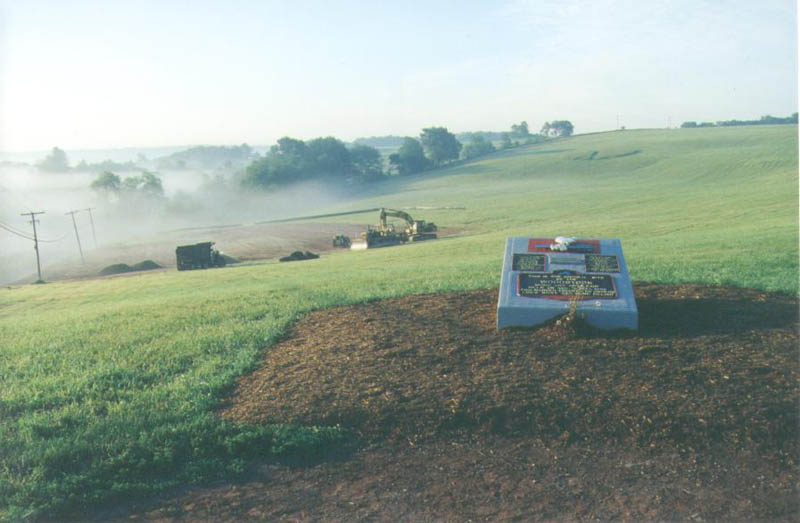
Get
Back--Woodstock 98...NOT!
by Haven James - posted August 1998
Preview: A Day In the Garden
Festival at Bethel
|
|
Day-tripper, yeah? Hard to imagine seeing Lou Reed in the sunshine, but stranger
things have happened. Reed, Joni Mitchell, Pete Townsend and a bouquet
of assorted veteran rock 'n' rollers will gather for A Day In
The Garden at Bethel this weekend [8/14--8/16, 1998] on the
original site of the 1969 Woodstock Music & Arts Fair. Though the
event marks the 29th anniversary of a generation's four days of infamy
on the late Max Yasgur's fertile pastures, make no mistake--this is not
Woodstock '98. Leave the tepee, cooler and camping tools home; just
bring cash and credit cards, maybe a folding chair or blanket, an
umbrella just because, and your reading glasses so you can study the
rules, like no cameras or picnic baskets (there will be food and
crafts booths to fill your needs).
The Gerry Foundation is now the owner of the
Woodstock Festival site and Alan Gerry and his associates have set out
to present this three-day daytime only event in a very designed
manner. Mike DiTullo, one of the coordinators of the festival, offers
the following perspective on the venue: "Our long-range plans are
to develop a permanent international attraction that's based on
American performing arts and music. This year, this is sort of like
our maiden voyage; we thought we would have a day in the garden, [so]
that's what we're calling the festival. [It's] three separate days,
it's not a Woodstock reunion, it's nothing like Woodstock.
We're limiting this to 30,000 persons a day. There's no overnight
camping; we're shooting for an older demographic, the baby-boomers
between 25 and 50/55, [and] we're looking to do just a nice two days
of music and fun. The third day we're targeting a younger
demographic--it's more modern, or alternative rock, you know, with the
Goo Goo Dolls and Marcy Playground. So what we're trying to say is the
first two days we're recognizing, and maybe showing our respect for,
the classic rock or the Hall of Famers, and then the third we're
saying that we're also thinking about the future and there are some
rookies out there that we also want to acknowledge and feature."
So, from the production standpoint, this is
not the same old ruse crew of likely suspects. It is a new,
well-funded, and, at least on paper, highly organized unit with
long-range plans, goals, and targets with pictures and arrows on 8x10
glossies. No, Arlo won't be there, but of course Richie Havens will,
along with Ten Years After, Melanie, and Pete Townsend. That's about
it for returning veterans of '69.
An enticing thing about the remainder of the
big acts scheduled is that many of them are not often seen in this
area. Friday brings Ziggy Marley and the Melody Makers (noon), Ten
Years After (1:30), Don Henley (3), Stevie Nicks (5), and late
addition Francis Dunnery. Saturday features Donovan (11 a.m.), Havens
(noon), Lou Reed (1), Joni Mitchell (3), and Townsend (5).
Even bigger news for some locals is the
appearance of a bevy of area bands throughout the three-day affair.
DiTullo and his assistant, Susan Leventoff, filled us in on these
blossoming poppies. "We have hired around 15 to 20 local
performers who will be playing throughout all three days. There is a
second stage so they'll be playing before the headliners and then in
between the headliners," DiTullo says. Ulster's own Perfect
Thyroid will open the show Sunday morning on the Main Stage. They'll
be followed by Dishwalla, Joan Osborne, Marcy Playground, Goo Goo
Dolls, and Third Eye Blind.
An almost-final list of the area bands booked
for Stage Two follows: Starting Friday at 9 a.m. they are Afroblue,
the Larry Hoppen Band, the Mountain Laurel Band, Pottersfield (who
wrote the festival song, "Day In The Garden"), Ellen Avakian,
Barclay Cameron, Micheal Kroll, and Whatch. Saturday brings Barbara
Paras, Gavin DeGraw, New Frontier, Greg Press, Dan Sherwin, the Rausch
Bros., the Don Lewis Band, and Blues 2000. Sunday wraps with Borilis,
The Works, The Flies, Wonderkind, Leslie Nuchow, Girlfriend, Jimsons
Lyric, and Trinket. And there were still discussions in process about
adding a few more Woodstock (the town) artists to the lineup, maybe
Justin Love's Big Red Rocket and the Dharma Bums. "That's quite a
lot of local talent we're featuring, and we're proud to do that,"
DiTullo says. "This is a great opportunity for these acts to be
playing with legendary performers."
The report from Bethel is that the
infrastructure is set and the site is ready to rock. Word is that it's
almost surreal there, and isn't that the way a garden is supposed to
be? Tickets are sort of surreal at this point, too. They are now
two-for-one, approximately $70 per day (for a pair) Friday and
Saturday and half that for Sunday. They can be purchased through
TicketMaster by phone or ordered directly using the www TicketMaster
or through the Day In The Garden website.
|
|
|